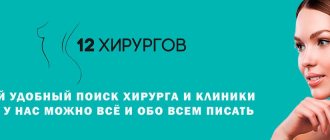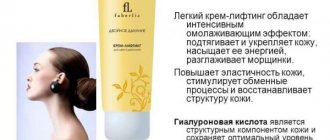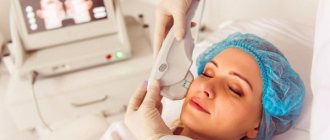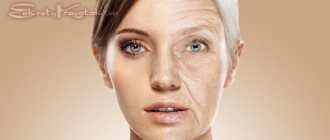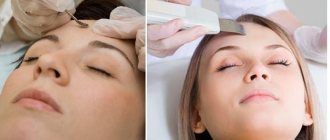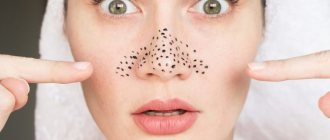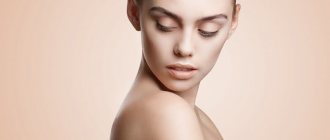“The natural process of skin aging”, “premature aging” - these phrases evoke extremely negative emotions in most people. It is impossible to reverse aging, but the latest advances in medicine and cosmetology make it possible to slow it down and minimize external manifestations.
Even when the body is in normal physical shape and the person is healthy, the first signs of aging appear after 20 years - these are small facial wrinkles, decreased elasticity, loss of natural and uniform complexion.
Today, there is a wide range of cosmetic procedures that can stimulate the skin, giving it freshness and elasticity, thereby reducing and slowing down the aging process of cells. One of these services is photorejuvenation.
Causes and types of skin aging
Content:
- Causes and types of skin aging
- Preventive measures to prevent aging processes
- Methods and techniques for skin rejuvenation: photorejuvenation
- What is facial photorejuvenation procedure?
- Types of photorejuvenation: main differentiation
- Possibilities of photorejuvenation: what to expect from the procedure
- Indications and contraindications: in what cases is photorejuvenation prescribed?
- Technique of the procedure
- After the session: how to care for your skin
- Photorejuvenation at home: how realistic is it?
The skin is the first and main barrier of the human body, which daily and fully experiences all the influences of the environment. Under the influence of the sun, wind, temperature changes, polluted air, aggressive cosmetics, improper care, excessive or insufficient humidity, skin cells lose moisture, become thinner, and lose their ability to regenerate. The production of collagen, a protein responsible for the elasticity of skin fibers, decreases in the skin.
In addition, any health problems are displayed on the skin - hormonal imbalances, disturbances in the digestive tract, nervous and cardiovascular diseases.
Age-related hormonal disruptions negatively affect the condition of the skin, when metabolic processes in the layers of subcutaneous fatty tissue are disrupted and muscle tone decreases.
Signs of aging can be wrinkles (facial, static and gravitational), age spots, sagging skin, swelling, uneven skin color, thinning, as a result of which the vascular network becomes clearly visible.
Aging can be natural or premature. The first type of process is genetically inherent in human cells, and its natural development cannot be stopped. As for premature aging, various factors can contribute to it - poor diet combined with bad habits, excessive tanning, acute and chronic diseases, and environmental exposure.
Rehabilitation period
Redness, swelling, and small bruises characteristic of the recovery period disappear on their own within 2-14 days. For most patients, rehabilitation takes 3-5 days. Some do not experience any unpleasant symptoms at all after the procedure. However, in any case, the skin is subjected to stress, and many processes associated with rejuvenation, cleansing, depigmentation, etc. begin to actively occur in it.
Therefore, doctors recommend:
- drink more purified water, since when the skin heats up, the liquid evaporates, and the rejuvenation process is impossible without hydration;
- give up/limit yourself from smoking (nicotine and other components of cigarette smoke and tar negatively affect the condition of blood vessels, complexion and neutralize the effect of the procedure);
- For about two weeks, avoid visiting the bathhouse, sauna, beach, or solarium.
If your general health deteriorates due to photorejuvenation, persistent swelling, hematomas and other symptoms, you should consult a doctor.
Preventive measures to prevent aging processes
The most popular ways to prevent premature aging and slow down the natural process of “growing up” of the skin are the following:
- use of photoprotectors;
- hydration;
- maintaining a healthy lifestyle.
It should be noted that exposure to ultraviolet radiation is beneficial for the skin only in strictly dosed quantities. Considering that every person encounters UVR every day, as soon as he goes outside, it is quite difficult to calculate even the approximate dose of radiation he receives. Facial skin that is not protected by clothing suffers especially. It’s not for nothing that many skin care products today contain special photoprotective substances and UV filters. Thanks to their application to the skin, part of the radiation undergoes a chemical reaction and does not reach the dermal cells.
A normal level of hydration is another factor that contributes to long-term preservation of youth. Due to environmental influences, internal diseases, temperature and other phenomena, the skin constantly loses moisture, which leads to premature cell death, so the use of moisturizers for it not only prolongs youth, but also strengthens its natural protection.
As for a healthy lifestyle, it includes giving up smoking and alcohol, playing sports, spending time in the fresh air, as well as a normal, balanced diet, without overusing sweets, fried, fatty, spicy foods.
Pros of phonophoresis
Most often, this procedure is used just for the face, but this is not the only option. The technology can be used even on the décolleté and hands.
Many people are interested in whether it is possible to carry out phonophoresis at home or not. As you can already understand, this requires a certain technique, which has its own price.
It is definitely not comparable to other household appliances, and therefore a trip to a cosmetologist seems more reasonable as a choice.
As mentioned earlier, phonophoresis gives the same result as a facelift using surgical methods. At the same time, you do not need to go under a knife or needle, and the rehabilitation that you need to undergo after the operation also takes a lot of time. Not only is the procedure painless, but also its speed. In this case, technology wins over old methods.
Since the session is quite short - about half an hour, and preparation for it takes a minimal amount of time, you can allocate the right time on almost any day you need. Moreover, practice shows that the result lasts for several years, which in itself is remarkable.
The full effect occurs only after 15 days, and therefore you need to schedule a visit to a cosmetologist in advance if you are preparing for some important event.
There is one more interesting feature. In areas where the skin is treated, the laser destroys all harmful bacteria and acne that may be on the dermis. In addition, local inflammation of the skin is relieved, as is peeling.
Methods and techniques for skin rejuvenation: photorejuvenation
Signs of aging are especially noticeable on the face - wrinkles and age spots, a “blurry” oval contour of the face, a gray, earthy skin tone, alas, do not add attractiveness at all.
In addition to various conservative ways to combat these manifestations, such as cosmetics for external use, as well as traditional medicine recipes, there are procedures developed by doctors and cosmetologists that help restore the properties of the skin, increase its elasticity, and smooth out wrinkles. All of them are divided into two main groups:
- surgical;
- hardware.
Surgical cosmetology involves performing appropriate operations to improve the condition of the skin.
Hardware methods of facial rejuvenation include:
- fractional rejuvenation;
- laser resurfacing;
- thermage;
- injection procedures;
- mesotherapy;
- ozone rejuvenation;
- photorejuvenation, and some other techniques.
Pros and cons of the procedure
The main advantages of IPL rejuvenation methods are the following facts:
- low traumatic procedures;
- high effectiveness in the fight against skin imperfections;
- the ability to prevent the occurrence of defects, wrinkles, etc.;
- absence of pronounced discomfort during the procedure;
- do not leave scars after light exposure;
- do not require lifestyle changes or cessation of work;
- long lasting effect.
Photorejuvenation is an excellent cosmetic method to solve many aesthetic and medical skin problems. However, it is not without its drawbacks. Among them are:
- an impressive list of contraindications;
- unpleasant, albeit temporary, consequences of the procedure in the form of swelling, redness, itching in areas bordering the mucous membranes;
- inability to use cosmetics in the first 3-5 days after light exposure;
- risk of photodermatosis, manifestations of hypersensitivity.
What is facial photorejuvenation procedure?
Facial photorejuvenation is a process during which a cosmetologist influences the skin using a special device with an attachment. This device emits light pulses of a certain length and frequency, and the nozzle accumulates and directs them.
In contact with skin cells, impulses become catalysts for certain processes:
- cells colored dark by melanin pigment absorb the light emitted by the nozzle, which causes the pigment to be destroyed and the skin to lighten;
- at a depth of 2-3 millimeters in the skin, the processes of synthesis of collagen and elastin fibers are activated;
- additional saturation of cells with oxygen occurs;
- light pulses push toxic substances out of cells;
- pathogenic microorganisms are destroyed;
- small capillaries coagulate and disappear, large ones become less noticeable.
Advantages of phototherapy
Photofacial rejuvenation has certain advantages over alternative anti-aging procedures. The cosmetology session is completely painless for the client. Professional devices are equipped with a special cooling and protection system, so they are completely safe. A session lasts on average 20-30 minutes, which significantly saves time.
This technique guarantees a comprehensive transformation of the face, since after laser manipulation wrinkles are smoothed out, and this contributes to skin elasticity and the elimination of pigmentation. Laser exposure has other advantages:
- minimizes pores on the face;
- helps improve skin elasticity;
- Phototherapy removes pigment spots very effectively;
- activates and stimulates the metabolic process at the cellular level;
- relieves scars, redness and other noticeable manifestations of eczema.
Other results can be achieved, this is individual for each patient. But the main advantage of photorejuvenation is the absence of wounds, cuts, swelling and other negative consequences that often arise as a result of injection techniques or surgery.
Types of photorejuvenation: main differentiation
Procedures are divided into types depending on what radiation sources are used in the process. So, they distinguish:
- laser photorejuvenation;
- collagen;
- elos;
- IPL.
The first type involves the use of a neodymium laser.
Collagen rejuvenation is a procedure using collagen lamps. These sources produce radiation of a certain length, due to which the synthesis of collagen fibers is activated.
Elos photorejuvenation combines the effects of a light beam and electric current.
During the IPL procedure, the facial skin is treated with pulses of light with a specified intensity and wavelength.
Advantages of visiting the Seline clinic
Without undue modesty, we advise you to contact our clinic for a rejuvenation procedure using light energy. For this we have everything you need:
- The latest, always in good working order, reliable equipment comes from the USA and Europe. We purchase equipment for facial photorejuvenation in the maximum configuration, as well as additional attachments, which allows us to work with various, even the most delicate areas of the skin, and solve a wide variety of patient problems.
- Several service options. We perform photorejuvenation using the BBL device, which stops the aging process at the genetic level. We also have at our disposal a device from the American brand LUMENIS - M22 IPL. He solves many skin problems, transforming the patient as if caught in the crosshairs of a photo editor. Another useful service of our clinic is laser photorejuvenation using the Harmony XL device. The cooling nozzle of the device eliminates all the unpleasant sensations that may arise during the procedure.
- Doctors who have been trained to work with each device available in the clinic. They know exactly what parameters to set and how to process areas so that the result is maximum.
These are three good reasons to choose Seline Clinic. And the incredibly beautiful and comfortable environment of our medical facility will be a bonus.
Possibilities of photorejuvenation: what to expect from the procedure
Based on reviews from cosmetologists, the likely results of photorejuvenation become noticeable after one or two sessions. Carrying out procedures makes it possible to:
- lighten skin color and make it more even;
- get rid of pigmentation, existing static and facial wrinkles, and also prevent the appearance of new ones;
- tighten the oval of the face, make its contours clearer and firmer;
- increase skin elasticity and firmness;
- reduce the number of spider veins;
- cleanse pores of impurities;
- get rid of acne;
- tighten pores.
FAQ
How to relieve swelling after the procedure?
Swelling is a normal reaction of the body to exposure to light. The permeability of the cell wall of the dermal vessels increases, the fluid leaves its previous place of residence and migrates. We see this as an increase in the size of certain areas of the face.
In the vast majority of cases, this reaction goes away on its own after 3-4 days. To alleviate the condition, you can use cold compresses, antihistamines (ask your doctor which ones), and soothing creams/gels. Herbs (herbal infusions) that have a diuretic and anti-inflammatory effect (for example, lingonberry leaves, erva woolly grass) also help relieve swelling.
Is it safe to do SMAS lifting after photorejuvenation?
These hardware procedures are perfectly combined. Photorejuvenation cannot affect the beauty of the oval of the face, eliminate sagging in the cheekbones, remove a double chin, or get rid of jowls. But ultrasonic SMAS lifting is capable of this. However, it is important to maintain an interval between procedures of 14-30 days.
Is it possible to do photorejuvenation after Botox?
Yes, you can. Botulinum therapy is effective against facial wrinkles and can prevent their appearance. And phototherapy copes well with age-related changes such as hyperpigmentation, uneven complexion, and “reformats” the skin into youth and beauty. However, the hardware procedure should be carried out 2-3 weeks after the injection. During this time, Botox will have time to “stand up” and maximize its effect blocking the transmission of nerve impulses.
What is forbidden to do after photorejuvenation?
After the procedure, you should not sunbathe, take a steam bath, sauna, drink alcoholic beverages, use aggressive cleansers, or medications without the consent of your doctor. It is important to take care of your skin, which has been exposed to intense light.
Indications and contraindications: in what cases is photorejuvenation prescribed?
The use of light exposure may be relevant for people who have the following skin defects:
- pigmentation of various etiologies (freckles, chloasma);
- acne;
- rosacea and angiomas;
- erythema that occurs after laser exposure to the skin;
- enlarged pores;
- vascular dysplasia;
- structural changes in connective tissue and collagen fibers, such as rosacea or actinic keratosis;
- small wrinkles of a static nature.
In what cases is the procedure prohibited? Photorejuvenation cannot be used for people with the following ailments, pathologies and conditions:
- infectious diseases and acute inflammatory processes;
- chronic skin diseases;
- pregnancy;
- diabetes mellitus;
- hormonal disorders;
- metal objects installed in the body, knitting needles, prostheses, pacemaker;
- herpetic diseases;
- psoriasis;
- blood diseases;
- oncology.
Two weeks before the rejuvenation process, you should avoid exposure to ultraviolet radiation - a fresh tan is a direct contraindication. Also, 2 weeks before the scheduled date of the session, it is prohibited to take photosensitizing drugs that change the skin's sensitivity to ultraviolet radiation.
What to choose
A cosmetologist will help you make the best choice between photorejuvenation and biorevitalization. The doctor focuses on the current state of the epidermis and takes into account the individual characteristics of the patient. It is the cosmetologist who will correctly determine the hardware effect or whether injections are needed in a particular case.
For those with dark skin and a fresh tan, the doctor will recommend biorevitalization. The injection technique will be offered to patients after 30–35 years of age. Those with dry, dehydrated, flabby epidermis are also better off using subcutaneous injections of hyaluronic acid.
Photorejuvenation is suitable if there are no serious aesthetic defects, the skin is sensitive, and the pain threshold is lowered. The procedure will help tidy up the epidermis of young patients. The intervention is not recommended for those with excessive dry skin.
Technique of the procedure
Photorejuvenation – does it hurt? This question interests anyone who has decided to conduct a session of returning youth.
The procedure does not cause particularly painful sensations, however, it is difficult to call it pleasant. During the process, the patient feels some effect on the skin - tingling, tingling, sometimes even burning.
Before starting, a special gel is applied to the skin, which protects the skin from overheating and burns. To avoid damage to the cornea, it is imperative to wear glasses. The cosmetologist uses a special attachment with a tip that focuses light pulses. This tip is used to treat specific areas of the skin.
The entire session lasts approximately 10-15 minutes, sometimes it can last up to 30-40 minutes.
After completion, the skin is treated with a gentle antiseptic and healing agent. For the first few hours, the patient will feel a slight burning sensation, and the skin will have a reddish color, like after an intense sun tan.
Despite the fact that the results of the first session can already be visually noticed after the redness disappears, the procedure should be carried out in a course to consolidate the effect for a longer time.
How many procedures are needed to achieve a positive result? The course ranges from 4 to 6 sessions - its duration is determined by the cosmetologist, based on the initial condition of the skin. There is an interval of 3 to 6 weeks between each session.
Best materials of the month
- Coronaviruses: COVID-19
- Antibiotics for the prevention and treatment of COVID-19: how effective are they?
- The most common "office" diseases
- Does vodka kill coronavirus?
- How to stay alive on our roads?
For whom is the procedure relevant?
Before deciding to undergo the procedure, you need to familiarize yourself with the indications for photorejuvenation.
- Phototherapy can be done for the first age-related skin changes that appear in women over 30 years of age. But laser therapy is also carried out in order to get rid of many problems with the epidermis, which occur even in young girls.
- The facial photorejuvenation procedure is used to combat age spots, freckles and wrinkles.
- This procedure is also used to get rid of gray or unhealthy skin color.
- Cosmetology sessions will help cope with dry skin, and also prevent peeling and a feeling of tightness.
- Facial phototherapy will help get rid of capillary networks that often appear on the skin, and will also narrow enlarged pores and cure acne.
This is an incomplete list of indications for the procedure. To be sure that laser treatment will help solve a particular problem, you need to consult with a cosmetologist.
After the session: how to care for your skin
Interestingly, photorejuvenation does not require any special skin care measures after it. When the redness goes away, you can even use decorative cosmetics if necessary, although it is better to still let the skin “come to its senses.”
In some cases, the face may become swollen after photorejuvenation. If facial swelling does not go away within 1-2 days, you should contact the doctor who performed the procedure.
As part of post-procedure care, the affected areas should be periodically applied with a moisturizing cream with an antiseptic effect. In addition, they must be protected from direct sunlight during the entire course. It is also undesirable to visit the sauna, bathhouse and solarium.
Preparatory activities
To prevent the development of complications after the procedure, doctors at our clinic recommend stopping tanning in any way 14-30 days in advance. You should protect your skin from exposure to UV rays, even if you are not going to the beach or solarium specifically for this. Cosmetics can help you.
You also need to stop taking for a month:
- non-steroidal anti-inflammatory drugs with antiplatelet properties;
- antibiotics;
- retinoids.
Nothing complicated. There are no other restrictions.
List of contraindications
When deciding to undergo facial photorejuvenation, you need to know the contraindications to the procedure. It is strictly forbidden to carry out a rejuvenation session in the presence of tumors and inflammatory processes that are at the acute stage. Such exposure is prohibited for women who have been diagnosed with hypertension or a febrile condition. In addition to the above contraindications, facial photorejuvenation is prohibited in the following cases:
- serious blood diseases;
- pregnancy and lactation;
- skin allergic reactions;
- the presence of diabetes mellitus and thyroid pathologies;
- epilepsy;
- cataracts, glaucoma;
- serious mental disorders;
- activation of the herpes virus.
Laser therapy is prohibited for patients under 16 years of age, as well as when using tranquilizers and antibiotics that have a strong effect on the body. There are several other strict contraindications to laser phototherapy. Manipulations should not be carried out immediately after returning from seaside resorts and if you have a fresh tan. This procedure is prohibited for women with very dark skin and those patients who have a tendency to develop keloid scars.

